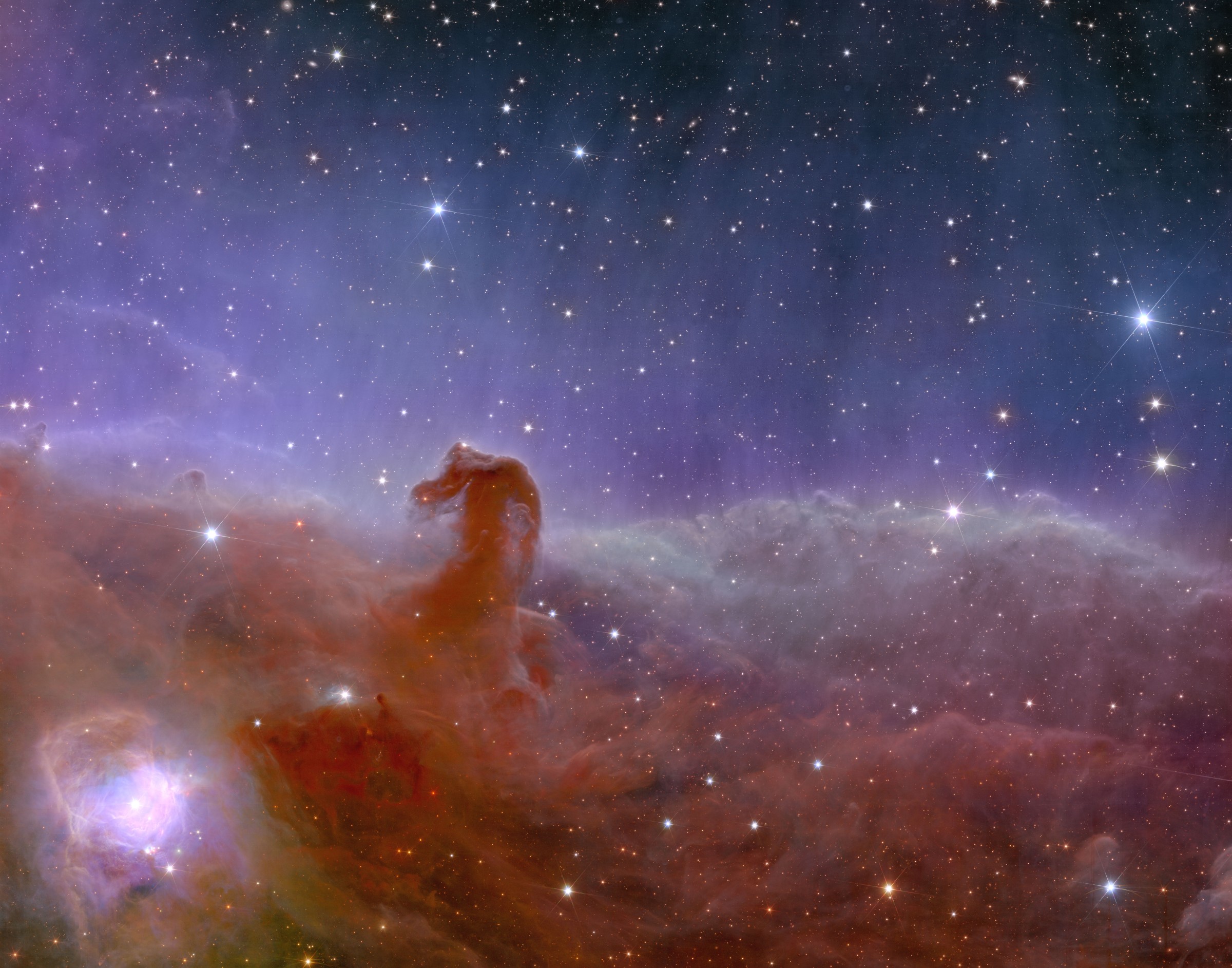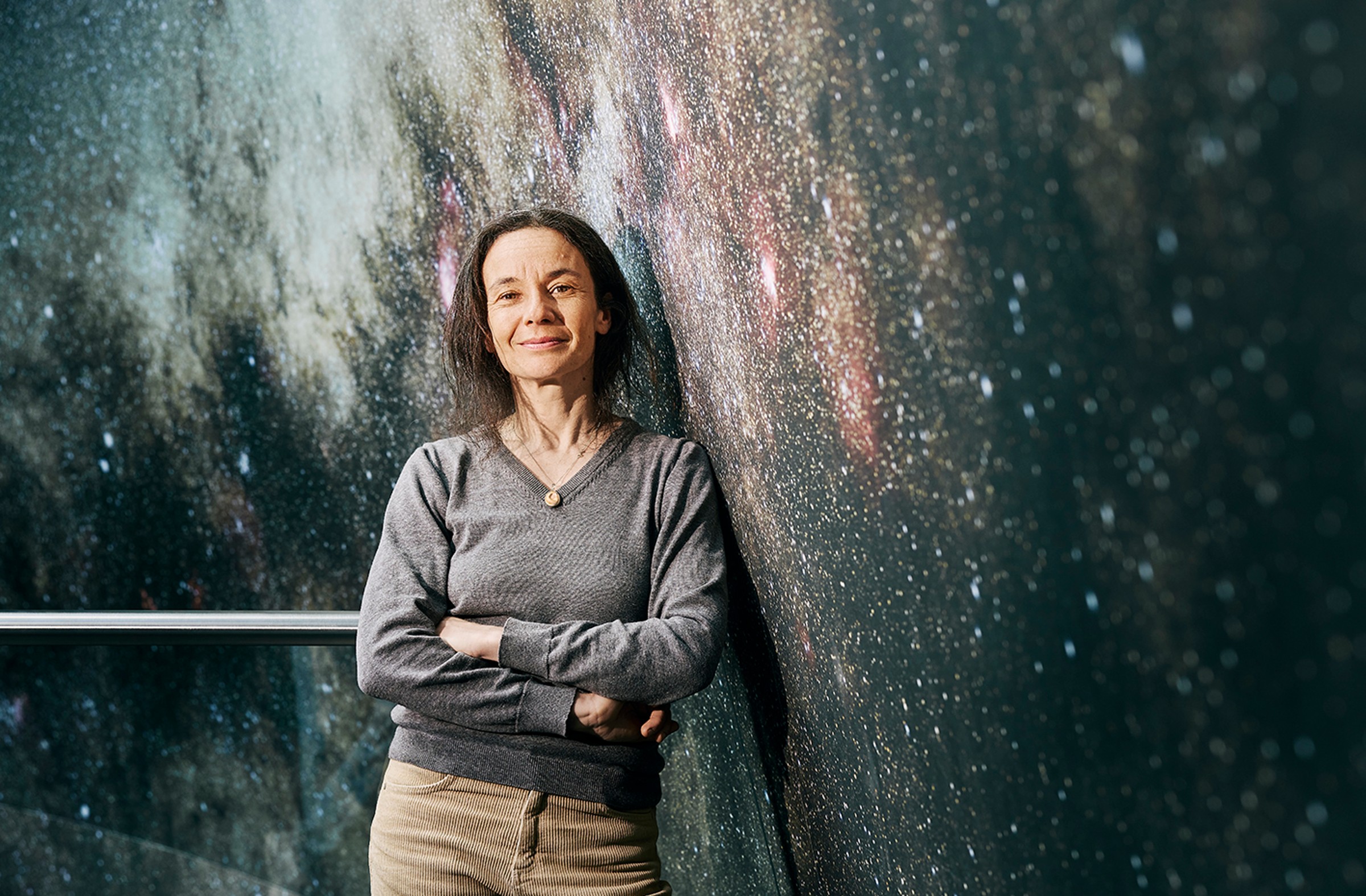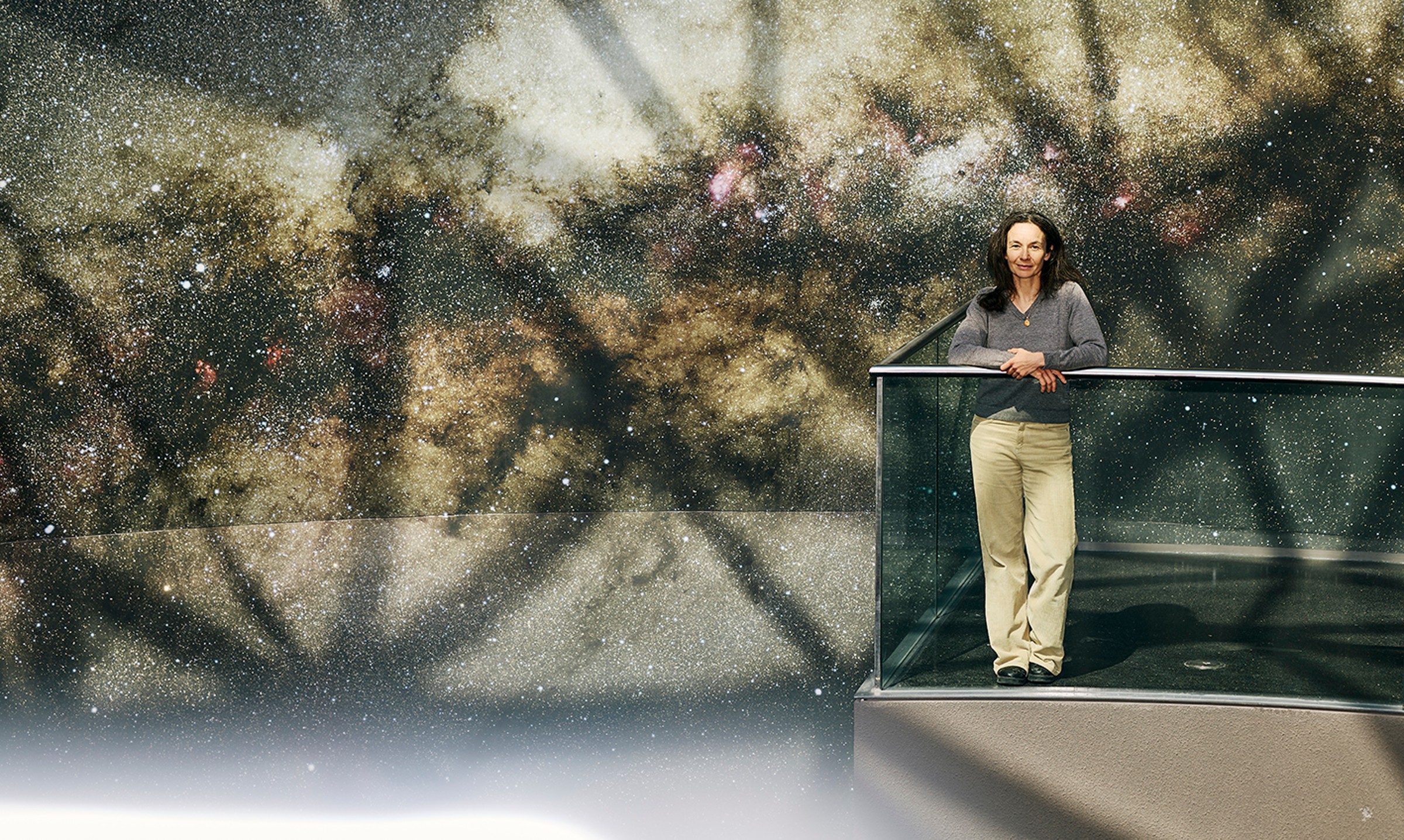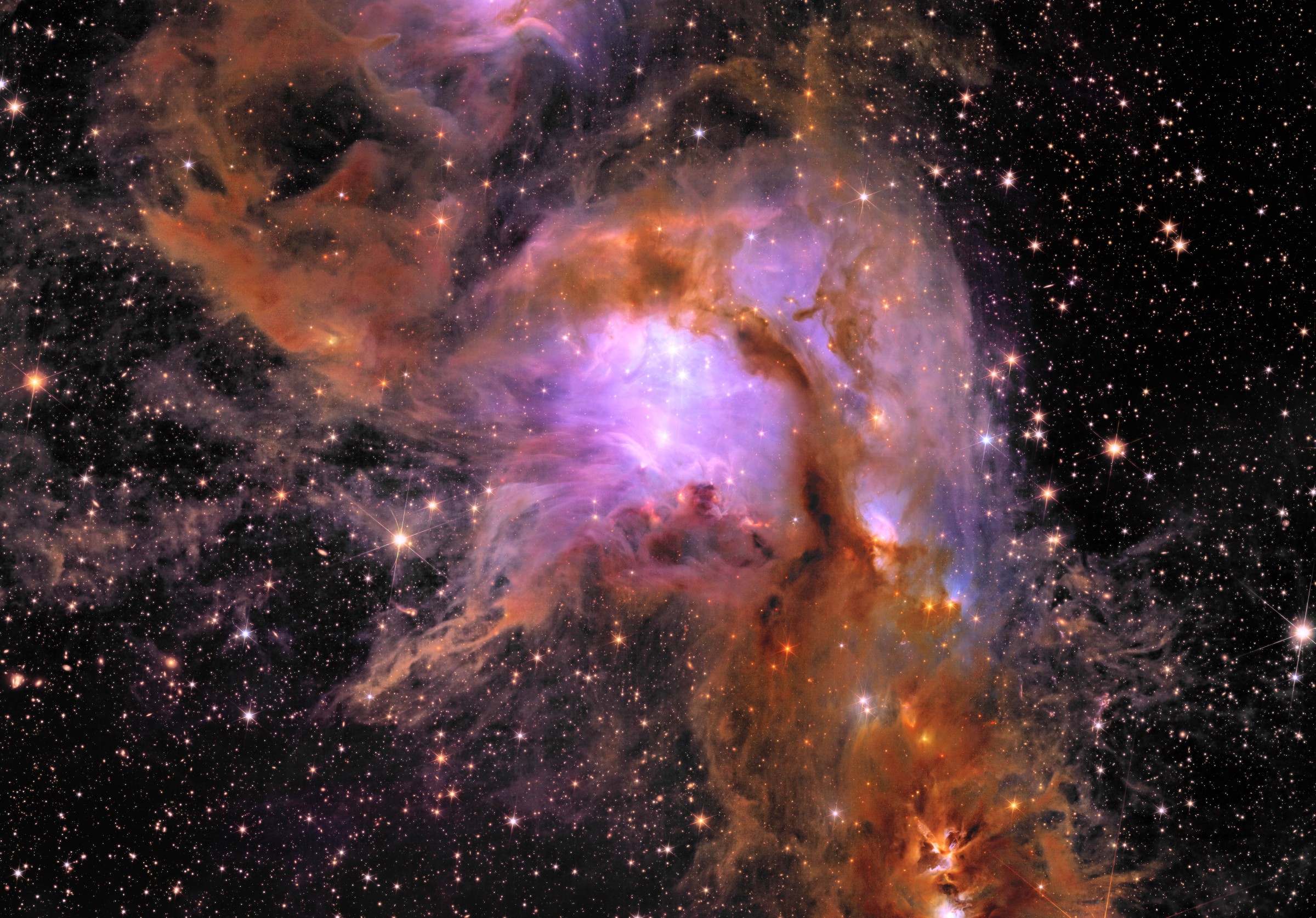Let’s start with the big question: Does life inevitably arise as a consequence of the physical principles that govern the universe?
Barbara Ercolano: Yes, that is the big question we’re working on. We started this work in the Universe Excellence Cluster back in 2006, which was one of the very first clusters of excellence to be awarded funding. Back then, the working hypothesis, shared by astrophysicists and particle physicists alike, was that the world, as we experience it, has its origins in the Big Bang. In the initial fractions of a second after the Big Bang, the physical principles were more or less established. These laws allowed the tiniest of density fluctuations to grow into agglomerations of mass and, much later, for stars and galaxies to form – and ultimately all the building blocks needed for life.
Horsehead Nebula in the constellation Orion. The panoramic image was taken by Euclid, ESA's newest space telescope, in which ORIGINS researchers are involved. Never before has a telescope been able to take such sharp astronomical images over such a large area of the sky while looking so deep into the distant universe.
© ESA/Euclid/Euclid Consortium/NASA, image processing by J.-C. Cuillandre and G. Anselmi, CC BY-SA 3.0 IGO
The search for life came into play with ORIGINS, the cluster of excellence that emerged from Universe in 2019 and which is now entering its second phase, having secured funding from the German Research Foundation and the German Science and Humanities Council.
Ercolano: Yes, we got biophysicists on board at that time. We needed this special expertise to investigate how initial molecules that store and propagate information could ultimately arise in the prevailing physical setting. In the search for the conditions for life, we’re now asking ourselves the question: In which atmospheres would this be possible? It’s likely we’ll get exact spectra from exoplanet atmospheres over the next 20 years. But that alone is not enough – we must investigate how geological processes affect them as well. As such, we’ve now brought the geosciences on board too.
In the initial fractions of a second after the Big Bang, the physical principles were more or less established. These laws allowed the tiniest of density fluctuations to grow into agglomerations of mass and, much later, for stars and galaxies to form – and ultimately all the building blocks needed for life.
Barbara Ercolano
How do you distill such a central question in the first place? And how do you break it down for individual disciplines and work packages?
Ercolano: We had a whole series of workshops and conferences with the entire ORIGINS community – with the overarching theme of how our universe became habitable. Everyone was given the opportunity to suggest projects that could help answer the question. Making a coherent program that is more than the sum of its parts – that took a solid year and a half of work. With the cluster and the infrastructure in the Munich area, we’ve built up a densely networked platform. And at this interface, we’re joining together different disciplines – geosciences and astrophysics for example – that can learn a shared language, along with their students and doctoral candidates, who then automatically form a generation for whom interdisciplinary work is second nature.
A neutrino experiment beneath the Pacific Ocean
Yoking together individual disciplines to tackle certain open questions seems to be a guiding principle for ORIGINS.
Ercolano: Yes, we have ten such connector projects. For example, a team of astrophysicists and cosmologists are investigating how the fundamental forces and geometries of the universe are related to dark matter and dark energy. Overall, we can build on the successes from the first phase and the general progress in our field from spectroscopic missions in space and new particle accelerators. For instance, our researchers managed to detect for the first time neutrinos that came directly to our planet from the center of a distant galaxy. Now we want to investigate how these neutrinos are related to dark matter. In this regard, we’ll probably be able to launch the pilot stage of a new neutrino experiment off the coast of Vancouver before the year is out. At a depth of over two kilometers beneath the Pacific, we plan to detect high-energy neutrinos in a huge detector system encompassing a cubic kilometer. As you can see, we’re always busy in a wide variety of fields simultaneously.
"With the cluster and the infrastructure in the Munich area, we’ve built up a densely networked platform", says Barbara Ercolano. "And at this interface, we’re joining together different disciplines – geosciences and astrophysics for example – that can learn a shared language, along with their students and doctoral candidates, who then automatically form a generation for whom interdisciplinary work is second nature."
© Florian Generotzky / LMU
Glass rain and a year lasting just a few hours
Perhaps we can briefly discuss one point in more depth: What can your own research contribute to the understanding of lifeforms?
Ercolano: I investigate how planets emerge from protoplanetary disks. We know today that all stars, like our sun, are born in a so-called accretion process, which generates these disks of matter around the stars. And it is precisely there that planets form. So if you see a sunlike or smaller star in the sky, you can be sure that it has a planetary system. When I was doing my doctorate, the first of these exoplanets was found – that was in 1995. Since then, we’ve discovered some 6,000 such planets. They exist in a wide variety of forms, some with very peculiar features – on some it doesn’t rain water but glass, while on others a year lasts just a few hours or days! I’m convinced this diversity cannot be attributed to the process of planetary formation itself, which is clearly a physical process and is the same everywhere. What’s different in each case is the starting conditions. And these in turn are dictated by the protoplanetary disks. What gases do they contain, and in what concentrations? How large is the star at the center of the disk? How much X-radiation does it emit? All these things have decisive influences. Ultimately, if a planet is to be habitable, it must have a certain size, must be rocky, and must have a moderate climate.
But that’s not the whole story, is it?
Ercolano: If you want to clarify how habitable planets are formed, you need to take a closer look at the initial conditions. Over the past 15 years, we’ve studied the relationship between the star, which supplies the energy, and the development of the surrounding disk, out of which the planets form. And in particular, we’ve begun to investigate the interface between the development of the disk and the formation of planets in order to understand how planetary atmospheres arise and what they can look like. The chemical elements available on the planet could be the construction set that makes the initial steps of life possible.
In my opinion, life must exist – somewhere. But if we were to find it on any one of the almost 6,000 exoplanets discovered so far, it would mean that life must be extremely common.
Barbara Ercolano
Is this confirmation that the composition of dust and gas clouds are inscribed in the conditions for life from the start?
Ercolano: No, not with certainty. The same composition of dust and gas can lead to life on one occasion and not on another. The other background conditions can be different, you see, such as the distance of a planet from its star, which can then set other chemical processes in motion. But when the distance to the star is such that a temperature prevails on the surface of the planet at which water is liquid, that’s a very good precondition. However, we’ve also learned that the moons of giant planets like Jupiter or Saturn could be habitable, not because they’re at the correct distance from the sun, but because the tidal forces of the planet warm the moon. And what’s especially interesting: This produces cycles of aridity and humidity on the moon, which favor the emergence of initial information-carrying molecules. This can also apply to free-floating planets, which were slung out of their solar system and drift lonely through space. As for the Earth, it should actually be dry according to our calculations. The water probably came here on water-rich meteorites or asteroids.
“So if you see a sunlike or smaller star in the sky, you can be sure that it has a planetary system,” says Barbara Ercolano.
© Florian Generotzky / LMU
Hundreds of Billions of planets in our galaxy
Among the 6,000 or so exoplanets that have been discovered, do we have a good candidate for life?
Ercolano: In my opinion, it must exist – somewhere. But if we were to find life on any one of these almost 6,000 exoplanets, it would mean that life must be extremely common. After all, there are hundreds of billions of planets in our galaxy alone. But what are the actual biosignatures we have to search for, the signs of life? I’m certain we’re going to see a plethora of papers over the coming years in which researchers claim to have found life. And a short time later, other papers will come along to take apart the indicators.
What could life out there look like? Completely different to life on Earth? There is a debate as to whether life has to be carbon-based.
Ercolano: It’s difficult to say. If it was based on a completely different chemistry – sulfur-based, say – we might not even recognize it.
What are your hopes for new space missions such as Twinkle, in which you’re also involved?
Ercolano: Twinkle will study the atmospheres of exoplanets in the infrared range. We expect it to reveal detailed insights into biosignatures and gas compositions. And it will provide a survey that will allow us to compare many planets for the first time. I’m leading three research teams that are addressing the question, among others, as to which hydrocarbons – important building blocks in prebiotic chemistry – can be found. In the context of ORIGINS 2, we’re also planning to add a new spectrograph to the telescope on Mount Wendelstein. This will serve a variety of functions, including the observation of exoplanets. Although it’s quite a small telescope, it has the advantage that we don’t have to wait for months to get observation slots as we do with the large telescopes.
Do we need a new physics?
The Euclid mission, in which ORIGINS is also playing a substantial role, has already delivered impressive data. How important is this for the new cluster?
Ercolano: With the Euclid mission, we’re entering the domain of precision cosmology. It allows us to measure density distributions in the cosmos with previously unknown resolution. This gives us good reason to expect insights into dark matter and dark energy: Can the contradictions in the calculations of fundamental cosmological constants be resolved? Or do we need a different cosmological model, a new physics?
All the research projects we’ve discussed create a constantly increasing flood of data. How do you handle this issue in ORIGINS?
Ercolano: Our concept for the ORIGINS Data Center commits us to preparing our data for the ORIGINS community, but also for researchers throughout the world, such that it is available, reproducible, and interoperable. This means we don’t just provide data and results, but also information about the methods. For our Dark Matter Center, we’ve already begun this work. We’ll also be getting several data stewards, who will adapt the data for the various disciplines. And last but not least, machine learning will also play an important role going forward.
Another view of the universe from Euclid: Messier 78, a vibrant nursery of star formation enveloped in a shroud of interstellar dust. Messier 78 lies 1,300 light-years away in the constellation of Orion.
© ESA/Euclid/Euclid Consortium/NASA, image processing by J.-C. Cuillandre (CEA Paris-Saclay), G. Anselmi; CC BY-SA 3.0 IGO
Major achievement for LMU: seven Clusters of Excellence approved
Read more
How do you plan to reach a wider audience with your findings?
Ercolano: We’ve long placed a high value on outreach, putting on hundreds of events. We collaborate, for example, with the Supernova exhibition center at the European Southern Observatory (ESO) in Garching. And we also work closely with the Deutsches Museum, where we plan to open a permanent exhibition on ORIGINS topics in 2029, which will include newly developed experiments for schoolchildren. In general, we will be boosting our activities for schoolchildren through the new Center for Origins Research Education (Core) in order to inspire youngsters with a love of science. After all, we need a new generation of curious minds who can help us explore the question as to the origin of life.
Prof. Barbara Ercolano leads a research group on planetary formation and protoplanetary disks at LMU and is future co-spokesperson for the Excellence Cluster ORIGINS: From the origin of the universe to the first building blocks of life, which brings together researchers from LMU and the Technical University of Munich (TUM). Future co-spokesperson is Prof. Stefan Schönert, Chair of Experimental Astroparticle Physics at TUM. The following partners are also involved: the Max Planck Institutes for Astrophysics, for Extraterrestrial Physics, for Physics, for Plasma Physics, and for Biochemistry, the European Southern Observatory (ESO), the Leibniz Supercomputing Centre (LRZ), and the Deutsches Museum.




